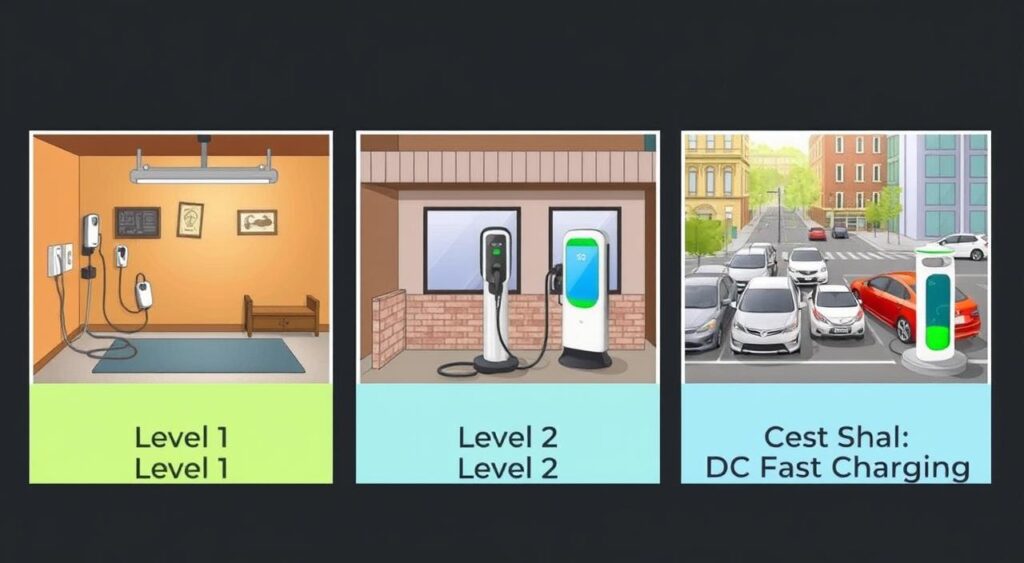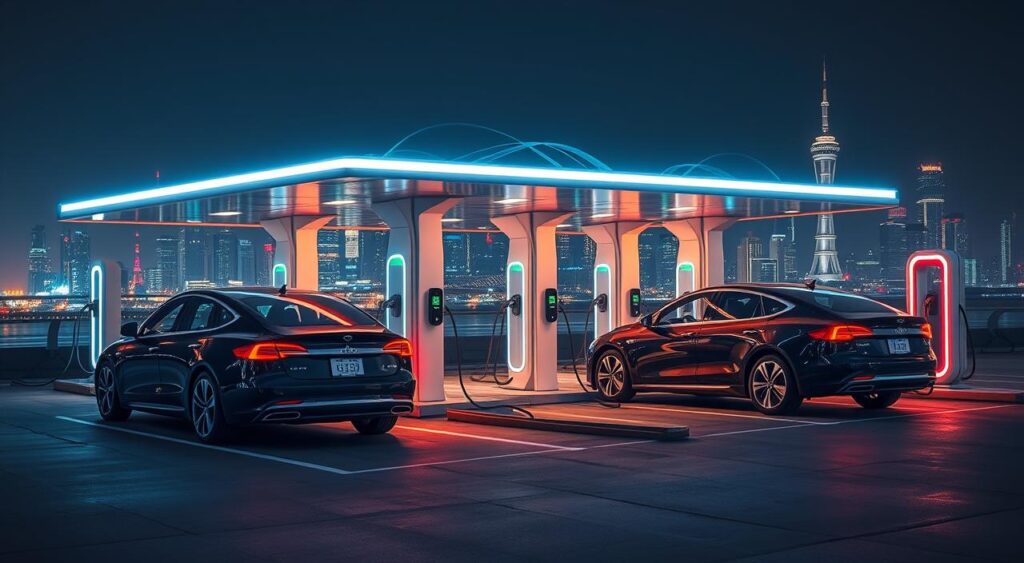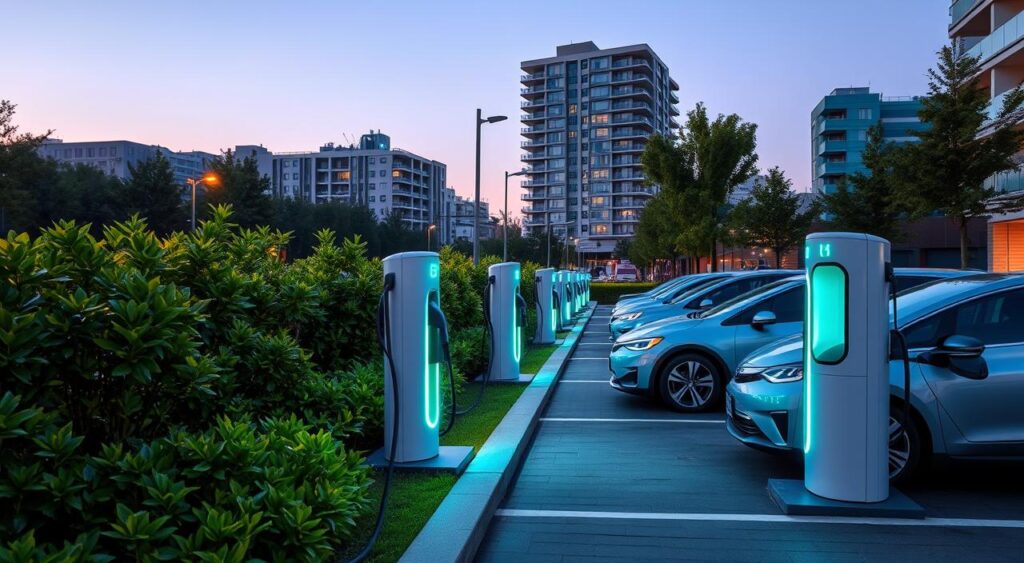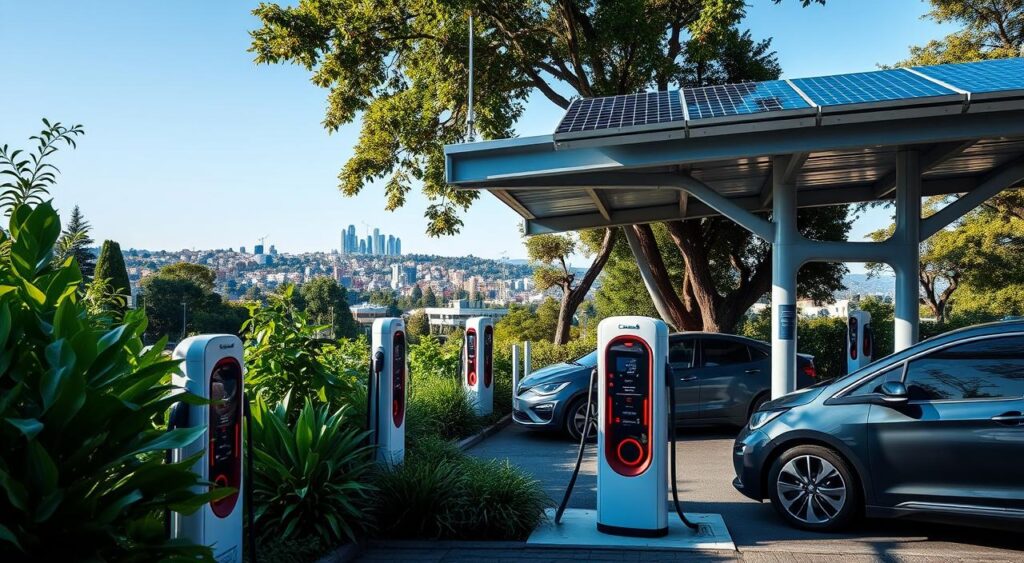EV charging stations, If you own an electric vehicle (EV) or are thinking about getting one, this guide is for you. It covers everything from the types of charging stations to how to use them. You’ll learn about the benefits of EVs, the different charging levels, and how to charge your car quickly.
It also talks about the future of EV charging technology. With this guide, you’ll know how to charge your EV easily. You’ll enjoy a smooth driving experience.
Key Takeaways
- Understand the different types of electric vehicles and the need for charging infrastructure
- Explore the various levels of EV charging stations and their charging capabilities
- Learn about the common EV charging connectors and the importance of using approved adapters
- Discover the factors that affect charging speed and how to optimize your charging experience
- Get familiar with the growing network of public EV charging stations and locating them
Understanding Electric Vehicles and the Need for Charging
electric vehicle charging infrastructure, Electric vehicles (EVs) are changing the car world. They are a green and efficient choice compared to gas cars. There are three main types: Battery Electric Vehicles (BEVs), Plug-in Hybrid Electric Vehicles (PHEVs), and Hybrid Electric Vehicles (HEVs). BEVs run on electricity only, making no emissions. PHEVs and HEVs cut down emissions more than gas cars.
What Is an Electric Vehicle?
An electric vehicle runs on electric motors and batteries. It’s good for the planet, saves money, and is quiet and smooth to drive.
Benefits of Electric Vehicles
Electric vehicles have many benefits. They don’t make emissions, which is better for the environment. Plus, they cost less to run and maintain than gas cars. Electric vehicles save money and are better for the planet.
The Growing Demand for EV Charging Infrastructure
electric vehicle charging infrastructure, More people want electric cars, so we need more charging spots. Having places to charge at home and in public helps people feel comfortable using EVs. It makes driving electric worry-free.
“The average EV consumer saves thousands of dollars across the life of the car, reduces toxic emissions, and helps reduce reliance on fossil fuels.”
Electric cars are the future of driving. With better batteries and lower prices, we’re moving towards a greener transport system. Knowing about EVs and charging helps us get there faster.
Types of EV Charging Stations
EV charging stations, When you’re charging your electric vehicle, you have three main options: Level 1, Level 2, and DC Fast. Each has its own speed, power, and setup needs. Knowing what each offers helps pick the best for you.
Level 1 Charging
Level 1 uses a 120-volt AC outlet, the kind in your home. It charges slowly, adding 3-6.5 miles per hour. It’s good for overnight charging but not for daily use because it takes too long.
Level 2 Charging
Level 2 uses 240 volts AC and is common at home and public spots. It adds 14-35 miles per hour. It’s often the top choice because it’s fast enough and easy to install.
DC Fast Charging
DC Fast Charging is the fastest, adding up to 10 miles per minute. It can fill an almost-empty battery to 80% in 30 minutes. These stations are perfect for long trips and quick charges.
| Charging Level | Voltage | Power Output | Charging Time |
|---|---|---|---|
| Level 1 | 120V AC | 3-6 kW | 8-12 hours |
| Level 2 | 240V AC | 7-22 kW | 2-6 hours |
| DC Fast Charging | 400-800V DC | 50-150+ kW | 15-45 minutes |

“Choosing the right charging level for your electric vehicle is key for a smooth and quick charge.”
EV Charging Connectors and Adapters
The world of electric vehicles (EVs) has many charging connectors. Each is made for different models and charging stations. Knowing about these connectors is key for EV owners to charge easily and safely.
Common EV Charging Connectors
EV charger installation, In North America, you’ll find J1772, CCS, CHAdeMO, and NACS (Tesla) connectors. The J1772 is for Level 1 and Level 2 AC charging. CCS and CHAdeMO are for DC Fast Charging. Tesla cars use NACS but come with adapters for other stations.
EV Adapters and Their Use
EV charging stations, Adapters can connect different connectors, but they’re not always safe. They can cause faults and safety issues. Only approved adapters, like the Level 2 AC adapter, are safe. These ensure your car charges right and safely.
| Connector Type | Maximum Power Output | Typical Use Case |
|---|---|---|
| J1772 (Type 1) | 7.2 kW | Level 1 and Level 2 AC Charging |
| Mennekes (Type 2) | 22 kW | Level 2 AC Charging (Europe) |
| CCS Type 1 (North America) | 360 kW | DC Fast Charging |
| CCS Type 2 (Europe) | 360 kW | DC Fast Charging |
| CHAdeMO | 400 kW | DC Fast Charging |
| GB/T AC (China) | 7.4 kW | AC Charging |
| GB/T DC (China) | 237.5 kW | DC Fast Charging |
The EV industry is growing, and charging connectors will soon be fewer. The North American Charging Standard (NACS) is being adopted by many. This will make charging easier and safer for EV owners.
Charging Speed and Factors Affecting It
Charging an electric vehicle (EV) can take anywhere from under 20 minutes to over 20 hours. The main factor is the Battery Management System (BMS). It considers the battery’s temperature, state of charge, and more to charge efficiently and keep the battery healthy.
How Long Does It Take to Charge an EV?
The time it takes to charge an EV varies. It depends on the battery size, the charger’s power, and the battery’s current charge level. Here’s a quick guide:
- Level 1 charging (standard household outlet) can take up to 20+ hours to fully charge an EV.
- Level 2 charging (240V) can charge an EV in 4-8 hours, depending on the vehicle and charging station.
- DC Fast Charging can fill an EV’s battery from 20% to 80% in 15-30 minutes.
Factors Affecting Charging Speed
Several factors affect how fast an EV charger installation. These include:
- Battery Management System (BMS): The BMS monitors the battery’s temperature, charge, and more to charge efficiently and protect the battery.
- Battery Temperature: Extreme temperatures slow down charging. The BMS tries to keep the battery at the best temperature.
- State of Charge (SoC): Charging is faster when the battery is less full. As it gets fuller, the rate slows down to avoid overheating.
- Charger Specifications: The charger’s power and voltage greatly affect charging speed. DC Fast Chargers are much faster than Level 1 or Level 2 chargers.
- EV Model Differences: Different EVs charge at different rates. For example, the Nissan Leaf charges at up to 6.6 kW, while the Porsche Taycan can charge at up to 225 kW.
| EV Model | Charging Speed (0-80% SoC) |
|---|---|
| Nissan Leaf | 6.6 kW AC charging: 7.5 hours 50 kW DC Fast Charging: 45 minutes |
| Porsche Taycan | 7.2 kW AC charging: 9 hours 225 kW DC Fast Charging: 22.5 minutes |
| Tesla Model 3 | 11 kW AC charging: 6 hours 250 kW DC Fast Charging: 25 minutes |
Knowing what affects EV charging speed helps you plan better. This ensures your EV is ready when you need it.

EV Charging Networks and Locating Stations
electric vehicle charging infrastructure, The electric vehicle (EV) market is growing fast. A nationwide network of public charging stations is being built to support this growth. Companies like EVgo, ChargePoint, and Electrify America are setting up stations at shopping centers, highway rest stops, and city streets.
EV owners can find nearby charging stations using online tools and mobile apps. These charging station locators give detailed info on each station. This makes it easy for EV drivers to find the right charging spot.
Public Charging Networks
The growth of public electric vehicle charging infrastructure is key for more electric vehicles. In the US, big public charging networks include:
- ChargePoint: Has over 68,000 charging spots and 1,500 DC Fast Charging units.
- EVgo: Offers over 1,200 DC Fast Chargers in 34 states with a subscription option.
- Electrify America: Is quickly adding fast-charging stations, with over 120 in Walmart lots across 34 states.
- Blink: Has 3,275 Level 2 and Level 3 public chargers in the US.
- Tesla: Runs a global network of Superchargers, with 1,604 stations and 14,081 Superchargers.
Charging Station Locators
Drivers can find EV charging stations using online tools and mobile apps. Popular charging station locators include:
- PlugShare: Offers info on over 140,000 public charging stations in the US.
- Google Maps and Waze: List EV charging stations, but are mostly used for driving directions.
- ChargeHub: Gives availability info for many chargers in the US.
- EVgo: Lets users reserve a charging spot for later in the day.
By using public charging networks and charging station locators, EV owners can easily find charging spots. This helps them plan their trips, ensuring their vehicles are always ready to go.
EV charging stations
public charging networks, The electric vehicle (EV) market is growing fast. To support this, EV charging stations are being set up everywhere. They are found in public areas, workplaces, and along highways. This makes it easy for EV owners to charge their cars.
Companies like ChargePoint and EVgo are leading in EV charging. ChargePoint works with 60% of Fortune 500 companies. They’ve helped power over 11.4 billion electric miles and cut down 2.5 million metric tons of greenhouse gas emissions. EVgo has over 1,000 fast charging stations in the U.S. and has seen a 400% increase in customers.
The Department of Energy gave EVgo a $1.05 billion loan to grow their network. GM, Pilot, and EVgo are also working together. They plan to add 2,000 charging stalls at 500 locations across the country.
| Location | Number of Stations | Number of Ports |
|---|---|---|
| Parking Structure A | 3 | 6 |
| Parking Structure B, B-Level | 1 | 2 |
| Parking Structure C, Blue Level | 1 | 2 |
| Parking Structure E | 36 | 36 |
| Parking Lot 3 | 2 | 3 |
| Parking Lot 6 | 1 | 2 |
| Parking Lot 10 | 2 | 4 |
| Parking Structure B, B Level | 3 | 6 |
| Parking Structure E | 8 | 16 |
As more people buy EVs, we need more charging spots. This will help drivers feel confident in switching to electric cars. With more charging stations, we’re getting closer to a greener future.
“The deployment of EV charging stations is a key step in creating a strong and accessible network for electric vehicles.”

Residential and Commercial EV Charging Solutions
fast charging solutions, The electric vehicle (EV) market is growing fast. Homeowners and businesses are looking for easy and reliable ways to charge EVs. The EV charging world is changing to meet this growing need.
Home Charging Options
Charging at home is a big plus for EV owners. Level 1 charging uses a standard outlet and is the simplest and cheapest. But it’s the slowest.
Level 2 charging, with a 240-volt setup, is faster and more common. It lets EV owners charge their cars quicker.
Workplace and Public Charging Solutions
Workplace charging and public charging solutions are key for EVs. They offer fast charging options for those without home charging. They’re great for commercial and fleet vehicles too.
Expanding charging infrastructure for fleets helps businesses go electric. It cuts costs and helps the environment.
“The availability of convenient and accessible charging solutions is essential for the widespread adoption of electric vehicles. By providing a range of charging options, from home to workplace and public settings, we can empower EV drivers and support the transition to a more sustainable transportation future.”
Putting EV charging stations in places like coffee shops and malls is smart. It makes charging easier for drivers and brings in extra money for owners. As EVs become more popular, the need for these charging spots will grow. This offers a good chance for businesses to make money while helping the planet.
Costs and Incentives for EV Charging Infrastructure
EV charging stations, Setting up electric vehicle (EV) charging stations can be pricey. But, there are government incentives and utility rebates to help lower the costs. The price depends on the charging level, power output, and site prep needs.
Level 1 charging, which uses a standard outlet, is the cheapest option. Level 2 and DC Fast Charging stations need more expensive upgrades. Many government incentives and tax credits are available to make installing charging stations easier for individuals, businesses, and cities.
- The Clean Vehicle Rebate Project (CVRP) offers rebates up to $4,500 for eligible new zero-emission or plug-in hybrid vehicles.
- The Charge Ready Home Rebate Program provides rebates up to $4,200 for installing a Level 2 (L2) EV charger within 120 days of getting an EV.
- The Consumer Assistance Program (CAP) offers $1,500 for eligible consumers retiring operational vehicles meeting income requirements, or $1,000 for all other vehicle owners.
- Residents in the South Coast Management District may receive up to $9,500 for replacing high-polluting vehicles with EVs or hybrids.
Utility companies also offer incentives and rebates to encourage EV charging. For example, SCE’s TOU-D-PRIME program gives lower rates for EV drivers. There are extra savings for charging at specific times and a possible monthly EV meter credit.
| Incentive Program | Rebate Amount |
|---|---|
| SCE’s Pre-Owned EV Rebate | $1,000 or $4,000 based on household income |
| Clean Vehicle Rebate Project (CVRP) | Up to $4,500 for eligible new zero-emission or plug-in hybrid vehicles |
| Charge Ready Home Rebate Program | Up to $4,200 for installing a Level 2 (L2) EV charger |
| Consumer Assistance Program (CAP) | $1,500 for eligible consumers retiring operational vehicles meeting income requirements, or $1,000 for all other vehicle owners |
By using these incentives and rebates, people and businesses can lower the costs of EV charging infrastructure. This makes it more affordable and appealing for switching to electric vehicles.
Emerging Technologies and Future of EV Charging
fast charging solutions, The electric vehicle (EV) industry is always changing. New battery tech and charging solutions are leading the way. These advancements are making EV charging faster and more efficient, driving the industry forward.
Advancements in Battery Technology
Better batteries mean EVs can go further and charge quicker. These improvements in EV battery technology are key. They help address concerns about battery capacity and encourage more people to choose EVs.
Wireless Charging and Other Innovations
Wireless charging technology is making charging easier. It lets vehicles charge without a plug. Other new charging solutions, like bidirectional charging and V2G, are also coming. They promise to make EVs even more convenient and integrated into our energy systems.
As EVs become more popular, these tech advancements will be vital. They will shape how we experience EVs and help more people switch to electric.
“The future of electric vehicle charging, EV charger installation is all about convenience, efficiency, and seamless integration with the broader energy ecosystem. From wireless charging to vehicle-to-grid capabilities, the industry is constantly pushing the boundaries of what’s possible.”
Conclusion
This guide has given you a deep look into electric vehicle charging stations. It covers the different types of charging and the infrastructure. You now know how to handle EV charging with ease.
The need for electric vehicles is rising fast. A strong charging infrastructure is key for their wide use. By keeping up with EV charging updates, you help make our transport greener.
The U.S. is at the forefront of EV charging with big investments. They aim to have 500,000 public chargers by 2030. By using the right charging options and finding easy stations, you support a cleaner transport system.







